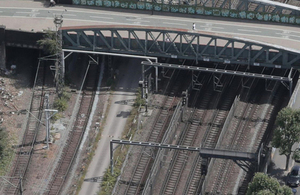Track worker near miss incidents at Camden Junction South
Investigation into two track workers narrowly avoiding being hit by a train, Camden Junction South, London, 28 February 2017.

Aerial view of site of first near miss (image courtesy of Network Rail)
Shortly after 01:00 hrs on 28 February 2017, two track workers narrowly avoided being struck by the 22:42 hrs passenger train service from Wolverhampton to London Euston. The incident took place close to Camden Junction South, as the train was on its final approach to Euston station. It was travelling on a line that the workers believed had been blocked to traffic to allow engineering work to take place.
The train was rounding a curve at approximately 47 mph (76 km/h) when the driver became aware of a track worker, who had been installing a possession limit board associated with the engineering work, moving quickly off the line ahead of him. The driver stopped his train and contacted the signaller to report a near miss with the track worker.
The signaller then authorised the driver to continue into Euston station. The driver had accelerated the train to 24 mph (39 km/h) when he again applied the brake in response to seeing a second track worker on the line ahead. The train stopped approximately 300 metres beyond its original stopping point, adjacent to the track worker who had also been installing equipment associated with the engineering work. The track worker moved off the line when he became aware of the approaching train, but did not have time to reach a position of safety (at least 1.25 metres from the nearest line) before the train reached him because he was working in an area some distance from the nearest position of safety.
There were no injuries.
Our investigation will determine the sequence of events. It will also include consideration of:
- the way in which information about engineering possessions is published and disseminated
- the management of information about engineering possessions within signal boxes
- any related issues associated with signaller workload and fatigue; and
- any relevant underlying management factors
Our investigation is independent of any investigation by the railway industry, the British Transport Police or by the industry’s regulator, the Office of Rail and Road.
We will publish our findings, including any recommendations to improve safety, at the conclusion of our investigation. This report will be available on our website.
You can subscribe to automated emails notifying you when we publish our reports.